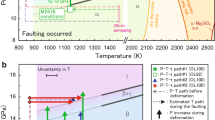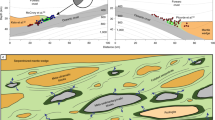Abstract
SHALLOW earthquakes are produced by brittle shear fracture of rock and/or fictional sliding on pre-existing fault surfaces1. At very high pressures, however, brittle fracture and frictional sliding are impossible because frictional resistance to movement on any potential fault surface is so great that ductile stress-relief processes accomodate strain at lower shear stresses than those necessary to activate faulting. Nevertheless, more than 20% of earthquakes with magnitudes greater than five occur at depths greater than 300km, where the pressure exceeds l0 GPa (ref. 2). Possible explanations for this paradox have been offered by several recent experimental studies of shearing instabilities associated with phase transformations at high 3–8. One of these mechanisms is associated with anticrack development during the olivine → spinel (α → γ) phase transformation in Mg2GeO4 at pressures of 1–2 GPa (refs 4–6); it is particularly attractive because it operates between mineral structures known to occur in the mantle. We show here that this mechanism also can operate in natural silicate olivine, (Mg,Fe)2SiO4, during onset of the α → β transformation at the much higher pressures at which deep earthquakes occur. These results lend strong support to the hypothesis that the anticrack mechanism is responsible for such earthquakes4.
This is a preview of subscription content, access via your institution
Access options
Subscribe to this journal
Receive 51 print issues and online access
$199.00 per year
only $3.90 per issue
Buy this article
- Purchase on Springer Link
- Instant access to full article PDF
Prices may be subject to local taxes which are calculated during checkout
Similar content being viewed by others
References
Scholz, C. C. H. The Mechanics of Earthquakes and Faulting (Cambridge University Press, 1990).
Frohlich, C. A. Rev. Earth planet Sci. 17, 227–254 (1989).
Kirby, S. H. J. geophys. Res. 92, 13789–13800 (1987).
Green, H. W. & Burnley, P. C. Nature 341, 733–737 (1989).
Green H. W. & Burnley, P. C. J. geol Soc. Lond. (in the press).
Burnley, P. C., Green, H. W. & Prior, D. J. geophys. Res. (in the press).
Meade, C. & Jeanloz, R. Nature 339, 616–618 (1989).
Meade, C. & Jeanloz, R. Eos 70, 1321 (1989).
Mukherjee, A. K., Bieler, T. R. & Chokshi, A. H. Proc. 10th Riso Int. Symp. on Metals and Material Science (eds Bilde-Sorensen, J. B. et al.) 207–231 (Riso National Laboratory, Roskilde, 1989).
Katsura, T. & Ito, E. J. geophys. Res. 94, 15663–15670 (1989).
Akaogi, M., Ito, E. & Navrotsky, A. J. geophys. Res. 94, 15671–15686 (1989).
Borch, R. S. & Green, H. W. Nature 330, 345–348 (1987).
Borch, R. S. & Green, H. W. Phys. Earth planet. Inter. 55, 269–276 (1989).
Walker, D., Carpenter, M. A. & Hitch, C. M. Am. Miner. (in the press).
Vaughan, P. J., Green, H. W. & Coe, R. S. Nature 298, 357–358 (1982).
Burnley, P. C. & Green, H. W. Nature 338, 753–756 (1989).
Vaughan, P. J., Green, H. W. & Coe, R. S. Tectonophysics 108, 299–322 (1984).
Green, H. W. Geophys. Monogr. 36, 201–211 (1986).
Author information
Authors and Affiliations
Rights and permissions
About this article
Cite this article
Green, H., Young, T., Walker, D. et al. Anticrack-associated faulting at very high pressure in natural olivine. Nature 348, 720–722 (1990). https://doi.org/10.1038/348720a0
Received:
Accepted:
Issue Date:
DOI: https://doi.org/10.1038/348720a0
This article is cited by
-
In situ X-ray and acoustic observations of deep seismic faulting upon phase transitions in olivine
Nature Communications (2022)
-
Dynamic anticrack propagation in snow
Nature Communications (2018)
-
Phase transformation and nanometric flow cause extreme weakening during fault slip
Nature Geoscience (2015)
-
NW Pacific slab rheology, the seismicity cutoff, and the olivine to spinel phase change
Earth, Planets and Space (2014)
-
Faulting of Rocks in a Three-Dimensional Stress Field by Micro-Anticracks
Scientific Reports (2014)
Comments
By submitting a comment you agree to abide by our Terms and Community Guidelines. If you find something abusive or that does not comply with our terms or guidelines please flag it as inappropriate.



